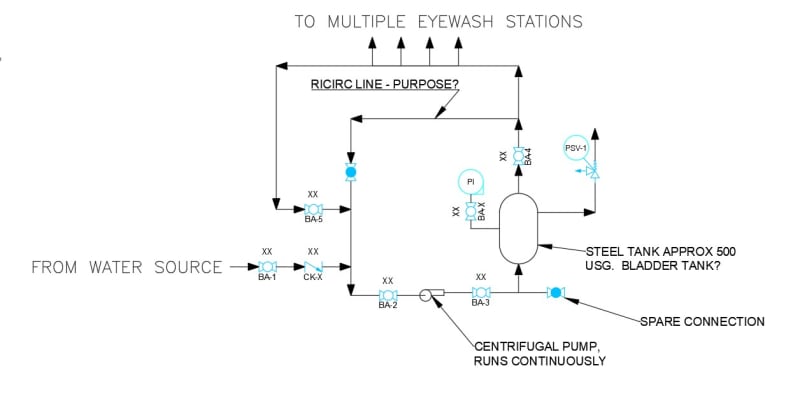Dersnerman
Mechanical
Hello All,
I'm trying to figure out the reasoning behind what appears to be a bizarre system installation I just inspected at a plant. It's for an emergency eyewash loop. See attached diagram I sketched for it. To me it would all make sense IF the tank was a pressure tank (bladder tank), since this would provide for some backup pressurized water storage in the event of a power failure. To be honest I'm not sure if it is a bladder tank or not. When we shut the pump off, the pressure started to fall (as measured by the pressure gauge on the tank). We assumed since the pressure was falling, that it wastn't a pressure tank (otherwise pressure would have been maintained). However, now that I'm thinking of it again, we didn't leave it for that long before coming to this conclusion. It could be that the bladder tank set passive pressure was lower than system pressure while the pump was running. Anyways, please lend me your thoughts and opinions!
Bonus question - what is the purpose of the little recirculation line from the tank outlet back to the pump inlet?
I'm trying to figure out the reasoning behind what appears to be a bizarre system installation I just inspected at a plant. It's for an emergency eyewash loop. See attached diagram I sketched for it. To me it would all make sense IF the tank was a pressure tank (bladder tank), since this would provide for some backup pressurized water storage in the event of a power failure. To be honest I'm not sure if it is a bladder tank or not. When we shut the pump off, the pressure started to fall (as measured by the pressure gauge on the tank). We assumed since the pressure was falling, that it wastn't a pressure tank (otherwise pressure would have been maintained). However, now that I'm thinking of it again, we didn't leave it for that long before coming to this conclusion. It could be that the bladder tank set passive pressure was lower than system pressure while the pump was running. Anyways, please lend me your thoughts and opinions!
Bonus question - what is the purpose of the little recirculation line from the tank outlet back to the pump inlet?

